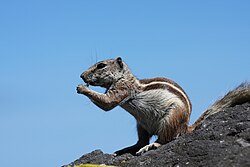Subclass: Theria
Infraclass: Eutheria
Order: Rodentia (rodents)


Rodents make up the largest order of mammals, with over 40% of mammalian species. They have two incisors in the upper and lower jaw which grow continually and must be kept short by gnawing. Most rodents are small though the capybara can weigh up to 45 kg (99 lb).
- Suborder: Sciuromorpha
- Family: Sciuridae (squirrels)
- Subfamily: Xerinae
- Genus: Atlantoxerus
- Barbary ground squirrel, A. getulusLC introduced
- Genus: Atlantoxerus
- Subfamily: Xerinae
- Family: Sciuridae (squirrels)
- Suborder: Myomorpha
- Family: Muridae (mice and rats)
- Genus: Canariomys
- Tenerife giant rat, C. bravoiEX [4]
- Gran Canaria giant rat, C. tamaraniEX
- Genus: Malpaisomys
- Lava mouse, M. insularisEX [5]
- Genus: Canariomys
- Subfamily: Murinae
- Genus: Mus
- House mouse, M. musculusLC introduced
- Genus: Rattus
- Genus: Mus
- Family: Muridae (mice and rats)
Order: Lagomorphs (lagomorphs)

The lagomorphs comprise two families, Leporidae (hares and rabbits), and Ochotonidae (pikas). Though they can resemble rodents, and were classified as a superfamily in that order until the early 20th century, they have since been considered a separate order. They differ from rodents in a number of physical characteristics, such as having four incisors in the upper jaw rather than two.
- Family: Leporidae (rabbits, hares)
- Genus: Oryctolagus
- European rabbit, O. cuniculusLC introduced
- Genus: Oryctolagus
Order: Erinaceomorpha (hedgehogs and gymnures)

The order Erinaceomorpha contains a single family, Erinaceidae, which comprise the hedgehogs and gymnures. The hedgehogs are easily recognised by their spines while gymnures look more like large rats.
- Family: Erinaceidae (hedgehogs)
- Subfamily: Erinaceinae
- Genus: Atelerix
- North African hedgehog, A. algirusLC introduced
- Genus: Atelerix
- Subfamily: Erinaceinae
Order: Soricomorpha (shrews, moles, and solenodons)

The "shrew-forms" are insectivorous mammals. The shrews and solenodons closely resemble mice while the moles are stout bodied burrowers.
- Family: Soricidae (shrews)
- Subfamily: Crocidurinae
- Genus: Crocidura
- Canarian shrew, Crocidura canariensisEN
- Greater white-toothed shrew, Crocidura russulaNA introduced
- Genus: Suncus
- Etruscan shrew, Suncus etruscusNA introduced
- Genus: Crocidura
- Subfamily: Crocidurinae
Order: Chiroptera (bats)


The bats' most distinguishing feature is that their forelimbs are developed as wings, making them the only mammals capable of flight. Bat species account for about 20% of all mammals.
- Suborder: Megachiroptera
- Family: Pteropodidae (flying foxes, Old World fruit bats)
- Genus: Rousettus
- Egyptian fruit bat, Rousettus aegyptiacusLC introduced
- Genus: Rousettus
- Family: Pteropodidae (flying foxes, Old World fruit bats)
- Suborder: Microchiroptera
- Family: Molossidae (free-tailed bats)
- Subfamily: Molossinae
- Genus: Tadarida
- European free-tailed bat, Tadarida teniotisLC
- Genus: Tadarida
- Subfamily: Molossinae
- Family: Vespertilionidae (vesper bats)
- Subfamily: Vespertilioninae
- Genus: Barbastella
- Barbastelle, Barbastella barbastellusNT
- Genus: Hypsugo
- Savi's pipistrelle, Hypsugo saviiLC
- Genus: Nyctalus
- Lesser noctule, Nyctalus leisleriLC
- Genus: Pipistrellus
- Kuhl's pipistrelle, Pipistrellus kuhliiLC
- Madeira pipistrelle, Pipistrellus maderensisVU
- Genus: Plecotus
- Canary big-eared bat, Plecotus teneriffaeVU
- Genus: Barbastella
- Subfamily: Vespertilioninae
- Family: Molossidae (free-tailed bats)
Order: Cetacea (whales)



The order Cetacea includes whales, dolphins and porpoises. They are the mammals most fully adapted to aquatic life with a spindle-shaped nearly hairless body, protected by a thick layer of blubber, and forelimbs and tail modified to provide propulsion underwater.
- Suborder: Mysticeti
- Family: Balaenopteridae (rorquals)
- Genus: Balaenoptera
- Common minke whale, Balaenoptera acutorostrataLC
- Bryde's whale, Balaenoptera edeniDD
- Blue whale, Balaenoptera musculusEN
- Fin whale, Balaenoptera physalusEN vagrant
- Genus: Megaptera
- Humpback whale, Megaptera novaeangliaeLC
- Genus: Balaenoptera
- Family: Balaenidae
- Genus: Eubalaena
- North Atlantic right whale, Eubalaena glacialisCR
- Genus: Eubalaena
- Family: Balaenopteridae (rorquals)
- Suborder: Odontoceti
- Family: Delphinidae (dolphins and pilot whales)
- Genus: Delphinus
- Short-beaked common dolphin, Delphinus delphisLC
- Genus: Globicephala
- Short-finned pilot whale, Globicephala macrorhynchusLC
- Long-finned pilot whale, Globicephala melasLC
- Genus: Grampus
- Risso's dolphin, Grampus griseusLC
- Genus: Lagenodelphis
- Fraser's dolphin, Lagenodelphis hoseiLC
- Genus: Orcinus
- Orca, Orcinus orcaDD
- Genus: Pseudorca
- False killer whale, Pseudorca crassidensNT
- Genus: Stenella
- Striped dolphin, Stenella coeruleoalbaLC
- Atlantic spotted dolphin, Stenella frontalisLC
- Genus: Steno
- Rough-toothed dolphin, Steno bredanensisLC
- Genus: Tursiops
- Common bottlenose dolphin, Tursiops truncatusLC
- Genus: Delphinus
- Family: Kogiidae (small sperm whales)
- Genus: Kogia
- Pygmy sperm whale, Kogia brevicepsDD
- Dwarf sperm whale, Kogia simaDD
- Genus: Kogia
- Family: Physeteridae (sperm whales)
- Genus: Physeter
- Sperm whale, Physeter macrocephalusVU
- Genus: Physeter
- Family: Ziphiidae (beaked whales)
- Genus: Hyperoodon
- Northern bottlenose whale, Hyperoodon ampullatusDD
- Genus: Mesoplodon
- Blainville's beaked whale, Mesoplodon densirostrisDD
- Gervais' beaked whale, Mesoplodon europaeusDD
- True's beaked whale, Mesoplodon mirusDD
- Genus: Ziphius
- Cuvier's beaked whale, Ziphius cavirostrisLC
- Genus: Hyperoodon
- Family: Delphinidae (dolphins and pilot whales)
Order: Artiodactyla (even-toed ungulates)

The even-toed ungulates are ungulates whose weight is borne about equally by the third and fourth toes, rather than mostly or entirely by the third as in perissodactyls. There are about 220 artiodactyl species, including many that are of great economic importance to humans.
- Family: Bovidae (cattle, antelope, sheep, goats)
- Subfamily: Caprinae
- Genus: Ammotragus
- Barbary sheep, Ammotragus lerviaVU introduced
- Genus: Ovis
- European mouflon, Ovis aries introduced
- Genus: Ammotragus
- Subfamily: Caprinae